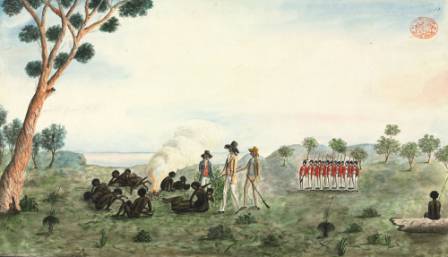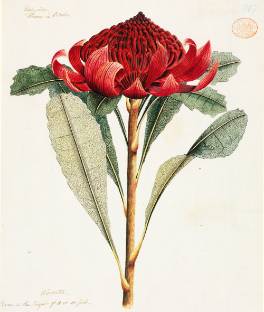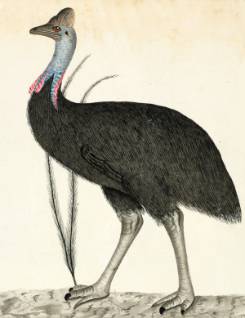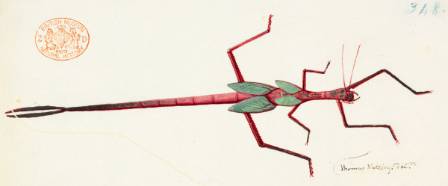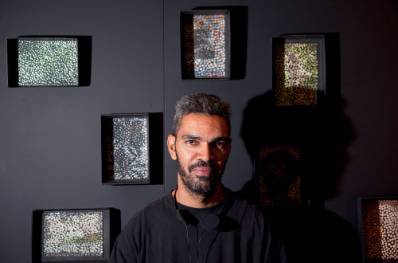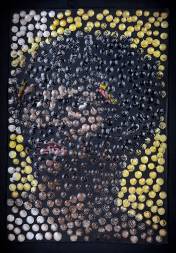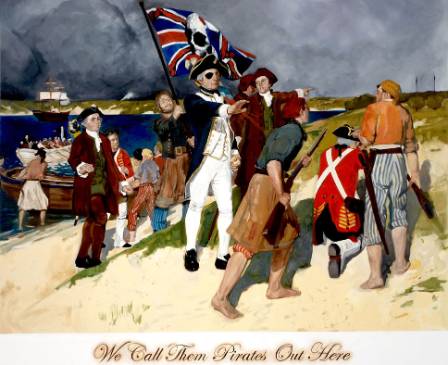Our Blue Zone's Images of Nature gallery welcomed a new temporary Australian-themed exhibition yesterday, showcasing the Museum's impressive 18th-century First Fleet collection of watercolours and drawings.
‘Mr White, Harris and Laing with a party of Soldiers visiting Botany Bay Colebee at that place, when wounded’, Port Jackson Painter/Watling collection. Watercolour, c1790–1797.
The British First Fleet arrived in Port Jackson (now Sydney) in January 1788, when 11 ships carrying about 1,400 people landed to establish the first penal colony. Among the sailors and convicts on board were draughtsmen, artists and forgers. They painted and drew the new landscape, its wildlife, and the Eora Nation clans who inhabited the area. Despite their lack of scientific accuracy, the images in the First Fleet collection are some of the most important in the Museum, providing a snapshot of a key moment in Australia's history. They are beautiful, telling images that provide rare natural history and ethnographic records.
Left: Waratah, Telopea speciosissima. Port Jackson Painter/Watling collection, watercolour, c1788–1797. The waratah is New South Wales' official floral emblem. Right: Southern cassowary, Casuarius casuarius. George Raper, watercolour and ink, 1792. This cassowary lives in the rainforest of northern Queensland.
In the first rotation of 32 First Fleet artworks on display now, you'll find gems like the cassowary and the well-known Waratah (above), official floral emblem of New South Wales, along with stranger-looking species like the Large pretty pink-winged stick insect below. There are also striking portraits of local tradesmen in the collection - often with dramatic stories to tell. The next selection of First Fleet artworks will be installed in the gallery in April.
The 600-strong First Fleet collection came into the Museum as three smaller ones known as the Raper, Watling and Port Jackson Painter collections after the artists whose work they contain. The drawings attributed to the Port Jackson Painter are thought to be the work of several unidentified artists.
Above. Large pink-winged stick insect, Podacanthus typhoon. Thomas Watling, watercolour and ink, c1792–1797. There are almost 150 species of stick insect in Australia.
The perspective of the Aboriginal Australian people who had been invaded, however, was not recorded in the First Fleet works. So our temporary exhibition features two newly-commissioned installations by Aboriginal artist Daniel Boyd whose provocative work comments on that ommission.
At the end of last year Daniel spent several months as an artist-in-residence here at the Museum researching and creating the pieces that are on show in the gallery now. He was putting the finishing touches to his installations last week.
Above: Australian Aboriginal artist Daniel Boyd unveils his Up in Smoke Tour installation in the Images of Nature gallery. Watercolours, 24 Museum archival boxes. Right, installation detail.
Daniel's work comments on the loss of native cultures recorded in the First Fleet collection, particularly on the British perception of Port Jackson at the time and the Aboriginal Australian people. It's the way these historic images obscure the original indigenous identity that interests the artist. His work in the gallery has also been inspired by the Museum's anthropological collection and he features Museum specimen boxes in his installations.
An earlier work by Daniel Boyd. We Call Them Pirates Out Here, 2006, oil on canvas. The work is kept in Sydney's Museum of Contemporary Art collection.
Daniel joins today's free Nature Live talk about The Art of the First Fleet (7 February) in the Attenborough Studio. And so too does the Museum's special collections librarian Lisa Di Tommaso, whose book explores The Art of the First Fleet. So pop along to the Darwin Centre's Attenborough Studio at 14.30 to hear and see more of these fascinating works first-hand.
Browse the Images of Nature gallery slideshow
Explore the First Fleet collection online
Watch artist Daniel Boyd on video discussing his new artwork and cultural background



